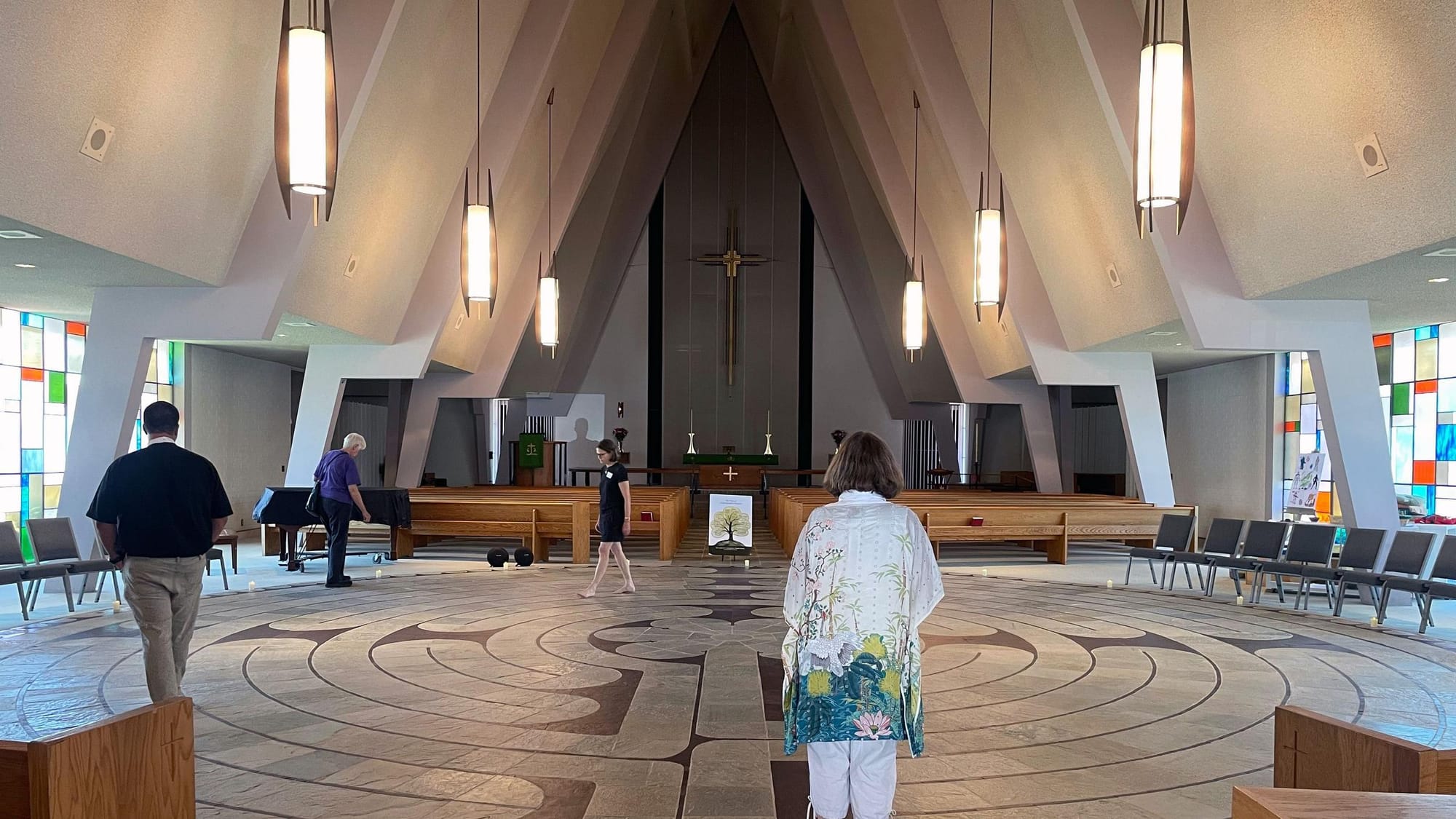LABYRINTH WALK
Christ the King Lutheran Church
Torrance
August 15, 2024
During a recent downward spiral, I drove south to Torrance for a labyrinth walk at Christ the King Lutheran Church. The event was organized by Katie Bull, local Labyrinth Society rep, who was certified to facilitate walks by Veriditas, a nonprofit dedicated to “personal and planetary change and renewal through the labyrinth experience.” Worst case, I might find some circuitous insight to justify my freelance rate.
Following an algorithmically determined route, I traced a whorled ramp onto the 110, then curved up the 405, finally landing among wood chips and succulents in the parking lot of a stuccoed A‑frame cathedral. I was late. The small group gathered in the auditorium was discussing sacred geometry as I snuck past a snack table in the lobby to snag a chair. We sat in a circle around the labyrinth. It was beautiful, laid in gray Himalayan slate with purple tile borders, snaking inward and doubling back in a complex coil, around 40 feet across, taking up more space than the church’s pews under towering popcorn ceilings. Morning light through Mondrianish stained glass haloed the floor we prepared to walk.
The first thing to know is that a labyrinth is not a maze, whatever the Greek myth says. There is only one path to the center of a labyrinth and there are no dead ends. A labyrinth is not a puzzle. “In a labyrinth, you go in to find yourself. In a maze, you go in to lose yourself,” Katie explained. Christ the King’s labyrinth features a classical 11-circuit pattern in the medieval style of France’s Chartres Cathedral and winds into a six-petaled flower core, accented with purple crosses. Deacon Dave told us that the congregation here worships around the labyrinth and adorns it with plants to honor Advent. It was designed and installed in 1998 by Alain Degand, a French stonemason responsible for several labyrinths around town, and blessed by Bishop Paul Egertson. There used to be a labyrinth outside too, until the church sold the surrounding land to a real estate developer that turned the hallowed ground into townhouses. Veriditas’s founder Lauren Artress, prophet of the modern Labyrinth Movement, is an Episcopal priest, but she evangelizes labyrinth-walking’s diverse spiritual history and broad therapeutic appeal in her book Walking a Sacred Path:Rediscovering the Labyrinth as a Spiritual Practice (1995). My new Torrance friends included a reiki enthusiast, a Catholic, and a popular podcaster’s cool hippie mom; they cited saints and Sufis alike.
A volunteer rang a bowl to commence the ceremony. Katie fumbled with Bluetooth speakers for an awkward minute before tossing on relaxing pandrum music, which Shazam identified as a track titled “Ancient Pandrum Relaxation Music.” I set an intention and entered forth, holding a heart-shaped pebble as instructed, keeping in mind the four Rs of walking a labyrinth: remembering, releasing, receiving, and returning. Quickly, I lost track of my progress, unsure how far I’d advanced or how many times “Ancient Pandrum Relaxation Music” had looped. Sans Soleil’s reading of Jimmy Stewart’s stalker sequence in Vertigo swirled in my mind; I felt wrapped in “a question of […] melancholy and dazzlement, so carefully coded within the spiral that you could miss it and not discover immediately that this vertigo of space in reality stands for the vertigo of time.” I remembered the adolescent comfort I found in the idea of some prescribed will of God, and contemplated the trust I’ve grasped for lately in a different force with unknowable shape called history. I exited and returned to my seat, to my dread and back pain, to my own path.






